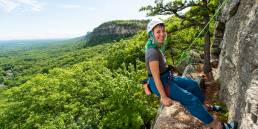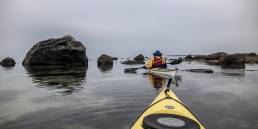Ask any connoisseur of mountain-related media what the standard-bearer for bad climbing movies is and the answer is almost always either Vertical Limit, the campy 2000 thriller loosely based on the Jim Wickwire and Louis Reichardt ascent of K2. Or maybe it’s Cliffhanger, the 1993 Sylvester Stallone action thriller inspired by the crash of a plane smuggling up to $600,000 worth of marijuana in Yosemite. However, after seeing Infinite Storm, it’s fair to wonder if there’s a new contender for the bad climbing movie championship belt. Based on a real-life rescue on Mount Washington, the roughly 90-minute Infinite Storm features everything from a cringe-worthy depiction of the White Mountains to a wildly over-the-top telling of real-life events.
Infinite Storm is a film adaptation of Ty Gagne’s article, “Footprints in the Snow Lead to an Emotional Rescue.” In the story, Gagne—author of Where You’ll Find Me and The Last Traverse—shares the dramatic and touching rescue of an anonymous hiker, given the name “John,” by Pam Bales, a member of Pemigewasset Search and Rescue who just happened to come came across a set of footprints in the snow while on a solo hike of Mount Washington.
The footprints lead to John, who Pam is able to revive and eventually lead off the mountain, where he abruptly leaves. A week later, the president of Pemigewasset Search and Rescue receives a letter and donation from John that details how he had planned to take his own life by letting the elements overwhelm him on Mount Washington and how Pam saved him. What made “Footprints in the Snow” resonate with so many people is that Pam rescued John in more than one way: on the mountain, she ushered him to safety, and on a larger scale she showed John that his life matters.
In focusing too much on the (exaggerated) theatrics of getting off the mountain, Infinite Storm misses the emotions that made the rescue so inspirational in the first place. And unlike movies such as Vertical Limit and Cliffhanger—which seemingly revel (along with their audiences) in their own absurdity—Infinite Storm is darkly serious, fully at odds with the sensationalized obstacles the characters must overcome. Here’s where we think the film fell unfortunately short:
1. The Terrain
Nothing in this movie resembles New Hampshire or the White Mountains. The movie was filmed in Slovenia and while the epic landscape provides a daunting visual backdrop, it fails to capture the true menace of Mount Washington—its accessibility.
2. The Trail
The Infinite Storm story takes place predominantly on the Jewell Trail, a well-traveled path leading from the Ammonoosuc Ravine Trailhead to the Gulfside Trail and ultimately to the summit of Mount Washington. While the movie portrays the Jewell Trail as incredibly steep, scree-laden, and obstacle-riddled, the fact is that it is perhaps the most gentle route to the summit of Mount Washington.
3. The Spruce Trap
An early moment of tension in Infinite Storm happens when Pam, having seemingly ventured into the alpine zone, falls into a spruce trap. Although spruce traps are found below treeline in the White Mountains, the odds of falling into one on a well-traveled route like the Jewell Trail are incredibly slim and even more so once a hiker gets above treeline. Furthermore, the odds of finding a spruce trap as deep as the well-over-head-high one Pam is trapped in borders on nonsensical.
4. John’s Cliff Dive
One of the few moments of unintentional comedy in Infinite Storm happens when John tries to escape from Pam by jumping off a cliff, only to survive his fall mostly unscathed because the cliff isn’t very high. There are a couple of problems with this fictionalized scene. First, ledges like the one John hurls himself off simply don’t exist on that part of Mount Washington and if they did, the odds of John continuing to walk following his leap are extremely small. Second, in the story “Footprints in the Snow,” John never considered running off, despite ample opportunities to do so. While John wanted to take his own life, he did not want to endanger anyone else’s.
5. The Log Crossing
Toward the end of the descent in Infinite Storm, Pam and John have to cross a river on an icy log in order to continue forward. Whether it’s the log crossing itself, the raging river that sweeps John away, the giant pool he eventually washes into, or the fact that he continues on after nearly drowning and becoming totally soaked (and presumably hypothermic), it’s hard to pick out the most preposterous part of the log crossing—it’s all foolishness. And for most outdoor recreationists, the scene merely reinforces a question they’ve probably been asking for much of the movie: where is Pam’s puffy coat?
6. The Truck
On their descent, Pam and John are emotionally crushed after they just miss hailing a truck that could deliver them to safety. On top of being melodramatic, the fictitious encounter is another of the movie’s failures to understand the terrain around Mount Washington. On the actual Jewell Trail, Pam and John would be reaching their own cars at the trailhead around the same time they encounter a road.
7. Seeing John Again
In Infinite Storm, Pam and John meet in a diner sometime after their harrowing day on Mount Washington. However, in real life, the two never saw each other again. This inaccurate ending undercuts the lesson of “Footprints in the Snow”:
“Some people have asked me if I tried to find John. The thought of searching for him felt wrong. As I’ve reflected more on this story and its relation to the issue of mental health, my response to the question about finding John has evolved. I have in fact found John, and he is very close by me. John is my neighbor, he is my good friend, a close colleague, a family member. John could be me.”
At some point in our lives, each of us has found ourselves walking with a sense of helplessness along a ridgeline and through a personal storm. Alone, devoid of a sense of emotional warmth and safety, and smothered by the darkness of our emotions, we’ve sought that place just off trail where we hoped to find some way to break free of our struggles and strife. Sadly and tragically, some do follow through. Many are able to quietly self-rescue, and others like John are rescued by others like Pam Bales.”
End Scene
You can argue that Hollywood’s depiction of mountaineering and climbing in movies like Infinite Storm feels (and looks) even sillier these days, thanks to a slew of incredible—and in one case Oscar-award winning—documentaries that have captured some of climbing’s most interesting personalities and monumental achievements. The theater of the “cutting the rope” scene in Vertical Limit or “Sarah’s fall” in Cliffhanger simply fail to meet the intensity of scenes like Alex Honnold pulling through the boulder problem 1,500 feet off the deck in Free Solo or the relief of Kevin Jorgenson sending pitch 14 in Dawn Wall.
Ultimately, Infinite Storm fails to deliver the tension captured in today’s rockumentaries and the joy found (although sometimes unintentional) in the climbing thrillers of the past. So while you can currently view this movie on a variety of streaming services, it’s probably better to just save your cash. We wish we had.
Tim Peck and Doug Martland
Tim and Doug met long ago at the Eastern Mountain Sports in Canton, Massachusetts. Bonding over a love of slick Quincy Quarry granite, White Mountain sufferfests, and scheming up adventures while folding tee-shirts, today Tim and Doug collaborate to write about their favorite outdoor activities and occasionally get nostalgic about tee-shirt tables.
Related Posts
April 24, 2024
What to Bring When Road Tripping with Your Dog
Prepare for the ultimate road trip with…




